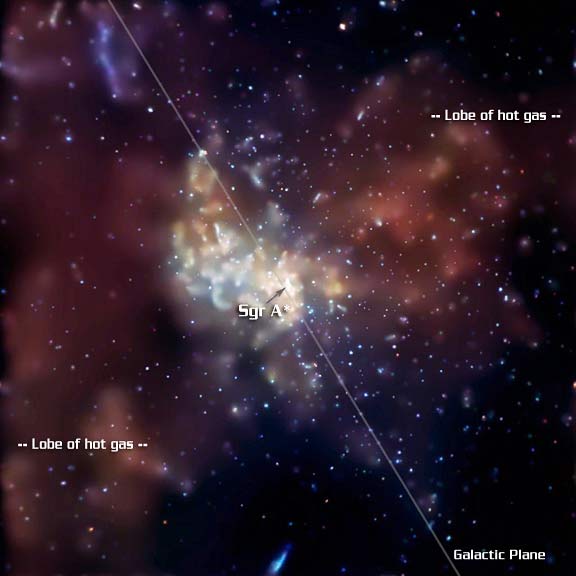Ancient Outburst of Milky Way's Black Hole Discovered

There is a slumbering matter-munching monster in the middleof our galaxy, and every once in a while, this black hole flares up andreleases plumes of X-rays.
Matter is constantly falling intothe Milky Way's central supermassive black hole, but sometimes enough builds upand gets hot enough to release a big flash. For instance, if humans hadan X-rayobservatory 300 years ago, we would have seen a giant flash caused by aclump of gas heating up as it fell toward the blackhole.
Although we missed this mighty burst, astronomers haverecently spotted echoes of it in a large gas cloud called Sagittarius B2. The X-raystook 300 years to travel from the central black hole to the cloud, and whenthey arrived, they collided with iron atoms, causing them to emit X-rays.
A team of Japanese astronomers observed the cloud in 1994 withthe ASCA X-ray satellite and then again in 2000 with NASA?s Chandra X-rayObservatory, in 2004 with the European Space Agency?s XMM-Newton X-rayObservatory, and in 2005 with Japan?s Suzaku X-ray satellite.
Today they announced the results of their investigation.
"By observing how this cloud lit up and faded over 10years, we could trace back the black hole?s activity 300 years ago," saidteam member Katsuji Koyama of Kyoto University. "The black hole was amillion times brighter three centuries ago. It must have unleashed anincredibly powerful flare."
The discovery of this flare may help explain why ourgalaxy's central black hole, called SagittariusA* (pronounced "A-star"), seems to be less active than those inother galaxies.
Breaking space news, the latest updates on rocket launches, skywatching events and more!
"We have wondered why the Milky Way?s black holeappears to be a slumbering giant," says team leader Tatsuya Inui of KyotoUniversity in Japan. "But now we realize that the black hole was far moreactive in the past. Perhaps it's just resting after a major outburst."
Since the center of our galaxy is 26,000 light-years fromEarth, both the X-ray flash and the echoes we're seeing now in Sagittarius B2 actuallyoccurred a longtime ago, roughly 26,300 years back.
The astronomers will detail their findings in an upcomingissue of the journal Publications of the Astronomical Society of Japan.
- VIDEO:Black Holes - Warpers of Time and Space
- VIDEO:Dive Into a Black Hole
- All About Black Holes

Clara Moskowitz is a science and space writer who joined the Space.com team in 2008 and served as Assistant Managing Editor from 2011 to 2013. Clara has a bachelor's degree in astronomy and physics from Wesleyan University, and a graduate certificate in science writing from the University of California, Santa Cruz. She covers everything from astronomy to human spaceflight and once aced a NASTAR suborbital spaceflight training program for space missions. Clara is currently Associate Editor of Scientific American. To see her latest project is, follow Clara on Twitter.
